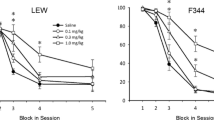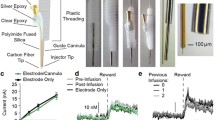Abstract
Rationale
Alterations in cost–benefit decision making accompany numerous neuropsychiatric conditions, including schizophrenia, attention deficit hyperactivity disorder, and addiction. Central cholinergic systems have been linked to the etiology and/or treatment of many of these conditions, but little is known about the role of cholinergic signaling in cost–benefit decision making.
Objectives
The goal of these experiments was to determine how cholinergic signaling is involved in cost–benefit decision making, using a behavioral pharmacological approach.
Methods
Male Long-Evans rats were trained in either “probability discounting” or “delay discounting” tasks, in which rats made discrete-trial choices between a small food reward and a large food reward associated with either varying probabilities of omission or varying delays to delivery, respectively. The effects of acute administration of different doses of nicotinic and muscarinic acetylcholine receptor agonists and antagonists were assessed in each task.
Results
In the probability discounting task, acute nicotine administration (1.0 mg/kg) significantly increased choice of the large risky reward, and control experiments suggested that this was due to robust nicotine-induced impairments in behavioral flexibility. In the delay discounting task, the muscarinic antagonists scopolamine (0.03, 0.1, and 0.3 mg/kg) and atropine (0.3 mg/kg) both significantly increased choice of the small immediate reward. Neither mecamylamine nor oxotremorine produced reliable effects on either of the decision making tasks.
Conclusions
These data suggest that cholinergic receptors play multiple roles in decision making contexts which include consideration of reward delay or probability. These roles should be considered when targeting these receptors for therapeutic purposes.



Similar content being viewed by others
References
Adriani W, Caprioli A, Granstrem O, Carli M, Laviola G (2003) The spontaneously hypertensive-rat as an animal model of ADHD: evidence for impulsive and non-impulsive subpopulations. Neurosci Biobehav Rev 27:639–651
Anderson KG, Diller JW (2010) Effects of acute and repeated nicotine administration on delay discounting in Lewis and Fischer 344 rats. Behav Pharmacol 21:754–764
Bickel W, Odum A, Madden G (1999) Impulsivity and cigarette smoking: delay discounting in current, never, and ex-smokers. Psychopharmacology 146:447–454
Cardinal RN, Robbins TW, Everitt BJ (2000) The effects of d-amphetamine, chlordiazepoxide, α-flupenthixol and behavioural manipulations on choice of signalled and unsignalled delayed reinforcement in rats. Psychopharmacology (Berl) 152:362–375
Dallery J, Locey ML (2005) Effects of acute and chronic nicotine on impulsive choice on rats. Behav Pharmacol 16:15–23
Evenden J, Ryan C (1996) The pharmacology of impulsive behavior in rats: the effects of drugs on response choice with varying delays of reinforcement. Psychopharmacology 128:161–170
Field M, Santarcangelo M, Sumnall H, Goudie A, Cole J (2006) Delay discounting and the behavioural economics of cigarette purchases in smokers: the effects of nicotine deprivation. Psychopharmacology 186:255–263
Floresco SB, St Onge JR, Ghods-Sharifi S, Winstanley CA (2008) Cortico-limbic-striatal circuits subserving different forms of cost–benefit decision making. Cognit Affect Behav Neurosci 8:375–389
George TP, Verrico CD, Picciotto MR, Roth RH (2000) Nicotinic modulation of mesoprefrontal dopamine neurons: pharmacologic and neuroanatomic characterization. J Pharmacol Exp Therapeut 295:58–66
Gleichgerrcht E, Ibáñez A, Roca M, Torralva T, Manes F (2010) Decision-making cognition in neurodegenerative diseases. Nat Rev Neurol 6:611–623
Ho MY, Mobini S, Chiang TJ, Bradshaw CM (1999) Theory and method in the quantitative analysis of “impulsive choice” behavior: implications for psychopharmacology. Psychopharmacology 146:362–372
Kalivas PW, Volkow ND (2005) The neural basis of addiction: a pathology off motivation and choice. Am J Psychiatry 162:1403–1413
Khokhlova VN, Marzhanova GK, Dolbakyan EE (2001) The role of muscarinic cholinoceptors in the retrieval of an operant food-related conditioned reflex in cats. Nuerosci Behav Physiol 31:291–298
Killeen PR (2011) Models of trace decay, eligibility for reinforcement, and delay of reinforcement gradients, from exponential to hyperboloid. Behavioral Processes 87:57–63
Kolokotroni KZ, Rodgers RJ, Harrison AA (2011) Acute nicotine increases both impulsive choice and behavioral disinhibition in rats. Psychopharmacology 217:455–473
Locey ML, Dallery J (2009) Isolating behavioral mechanisms of intertemporal choice: nicotine effects on delay discounting and amount sensitivity. J Exp Anal Behav 91:213–223
Locey ML, Dallery J (2011) Nicotine and the behavioral mechanisms of intertemporal choice. Behav Process 87:18–24
Mazur JE (1987) An adjusting amount procedure for studying delayed reinforcement. In: Commons ML, Mazur JE, Nevin JA, Rachlin H (eds) Quantitative analysis of behavior: the effects of delay and of intervening events on reinforcement value. Erlbaum, Hillsdale, pp 55–73
Mendez IA, Simon NW, Hart N, Mitchell MR, Nation JR, Wellman PJ, Setlow B (2010) Self-administered cocaine causes long-lasting increases in impulsive choice in a delay discounting task. Behav Neurosci 124:470–477
Mitchell SH (1999) Measures of impulsivity in cigarette smokers and nonsmokers. Psychopharmacology 146:455–464
Mitchell MR, Vokes CM, Blankenship AL, Simon NW, Setlow B (2011) Effects of acute administration of nicotine, amphetamine, diazepam, morphine, and ethanol on risky decision-making in rats. Psychopharmacology 218:703–712
Mitchell MR, Mendez IA, Vokes CM, Damborsky JC, Winzer-Serhan UH, Setlow B (2012) Effects of developmental nicotine exposure in rats on decision making in adulthood. Behav Pharmacol 23:34–42
Mukhin AG, Kimes AS, Chefer SI, Matochik JA, Contoreggi CS, Horti AG, Vaupel DB, Pavlova O, Stein EA (2008) Greater nicotinic acetylcholine receptor density in smokers than in nonsmokers: a PET study with 2-18F-FA-85380. J Nucl Med 49:1628–1635
Nakamura M, Oshima A, Fujimoto Y, Maruyama N, Ishibashi T, Reeves KR (2007) Efficacy and tolerability of varenicline, an [alpha]4[beta]2 nicotinic acetylcholine receptor partial agonist, in a 12-week, randomized, placebo-controlled, dose-response study with 40-week follow-up for smoking cessation in Japanese smokers. Clin Ther 29:1040–1056
Newhouse P, Potter A, Singh A (2004) Effects of nicotinic stimulation on cognitive performance. Curr Opin Pharmacol 4:36–46
O'Hare E, Weldon DT, Bettin K, Cleary J, Mach JR (1997) Serum anticholinergic activity and behavior following atropine sulfate administration in the rat. Pharmacol Biochem Behav 56:151–154
Perry ML, Andrzejewski ME, Bushek SM, Baldo BA (2010) Intra-accumbens infusion of a muscarinic antagonist reduces food intake without altering the incentive properties of food associated cues. Behav Neurosci 124:44–54
Plakke B, Ng C, Poremba A (2008) Scopolamine impairs auditory delayed matching-to-sample performance in monkeys. Neurosci Lett 438:126–130
Potter A, Newhouse P (2005) Cognitive effects of acute nicotine and ultra low-dose mecamylamine in attention-deficit/hyperactivity disorder. Biol Psychiatry 57:69s
Potter AS, Newhouse PA (2008) Acute nicotine improves cognitive deficits in young adults with attention-deficit/hyperactivity disorder. Pharmacol Biochem Behav 88:407–417
Potter AS, Newhouse PA, Bucci DJ (2006) Central nicotinic cholinergic systems: a role in the cognitive dysfunction in attention-deficit/hyperactivity disorder? Behav Brain Res 175:201–211
Potter AS, Ryan KK, Newhouse PA (2009) Effects of acute ultra-low dose mecamylamine on cognition in adult attention-deficit/hyperactivity disorder (ADHD). Hum Psychopharmacol 24:309–317
Potter AS, Bucci DJ, Newhouse PA (2011) Manipulation of nicotinic acetylcholine receptors differentially affects behavioral inhibition in human subjects with and without disordered baseline impulsivity. Psychopharmacology 220:331–340
Pratt WE, Blackstone K (2009) Nucleus accumbens acetylcholine and food intake: decreased muscarinic tone reduces feeding but not food-seeking. Behav Brain Res 198:252–257
Rachlin H, Raineri A, Cross D (1991) Subjective probability and delay. J Exp Anal Behav 55:233–244
Reynolds B, Richards J, Horn K, Karraker K (2004) Delay discounting and probability discounting as related to cigarette smoking status in adults. Behavioral Processes 64:333–344
Rice M, Cragg S (2004) Nicotine amplified reward-related dopamine signals in striatum. Nat Neurosci 7:583–584
Setlow B, Mendez IA, Mitchell MR, Simon NW (2009) Effects of chronic administration of drugs of abuse on impulsive choice (delay discounting) in animal models. Behav Pharmacol 20:380–389
Simon NW, Gilbert RJ, Mayse JD, Bizon JL, Setlow B (2009) Balancing risk and reward: a rat model of risky decision making. Neuropsychopharmacology 34:2208–2217
St Onge JR, Floresco SB (2008) Dopaminergic modulation of risk-based decision making. Neuropsychopharmacology 34:1–17
St Onge J, Floresco SB (2009) Prefrontal cortical contribution to risk-based decision making. Cerebr Cortex 20:1816–1828
St Onge J, Chiu Y, Floresco SB (2010) Differential effects of dopaminergic manipulations on risky choice. Psychopharmacology 211:209–221
Stanis J, Marquez Avila H, White M, Gulley J (2008) Dissociation between long-lasting behavioral sensitization to amphetamine and impulsive choice in rats performing a delay-discounting task. Psychopharmacology 199:539–548
Thompson A, Molina B, Pelham W, Gnagy E (2007) Risky driving in adolescents and young adults with childhood ADHD. J Pediatr Psychol 32:745–759
Warpman U, Nordberg A (1995) Epibatidine and ABT 418 reveal selective losses of alpha 4 beta 2 nicotinic receptors in Alzheimer brains. NeuroReport 6:2419–2423
Weiler JA, Bellebaum C, Brüne M, Juckel G, Daum I (2009) Impairment of probabilistic reward-based learning in schizophrenia. Neuropsychology 23:571–580
Xie X, Arguello AA, Reittinger AM, Wells AM, Fuchs RA (2012) Role of nicotinic acetylcholine receptors in the effects of cocaine-paired contextual stimuli on impulsive decision making in rats. Psychopharmacology. doi:10.1007/s00213-012-2715-z
Yip S, Sacco K, George T, Potenza M (2009) Risk/reward decision-making in schizophrenia: a preliminary examination of the influence of tobacco smoking and relationship to Wisconsin Card Sorting Task performance. Schizophr Res 110:156–164
Acknowledgments
This research was supported by NIH grants MH65728 (IAM), AG029421 (JLB), and DA024671 (BS).
Conflicts of interest
We have no conflicts of interest regarding the contents of this manuscript.
Author information
Authors and Affiliations
Corresponding author
Rights and permissions
About this article
Cite this article
Mendez, I.A., Gilbert, R.J., Bizon, J.L. et al. Effects of acute administration of nicotinic and muscarinic cholinergic agonists and antagonists on performance in different cost–benefit decision making tasks in rats. Psychopharmacology 224, 489–499 (2012). https://doi.org/10.1007/s00213-012-2777-y
Received:
Accepted:
Published:
Issue Date:
DOI: https://doi.org/10.1007/s00213-012-2777-y




